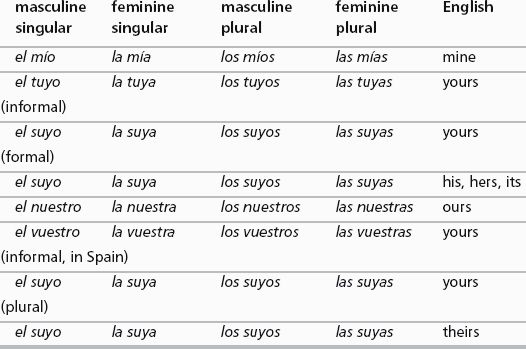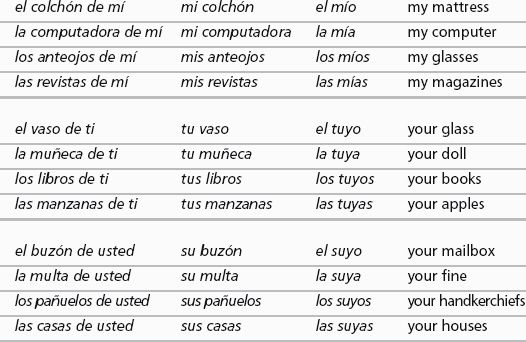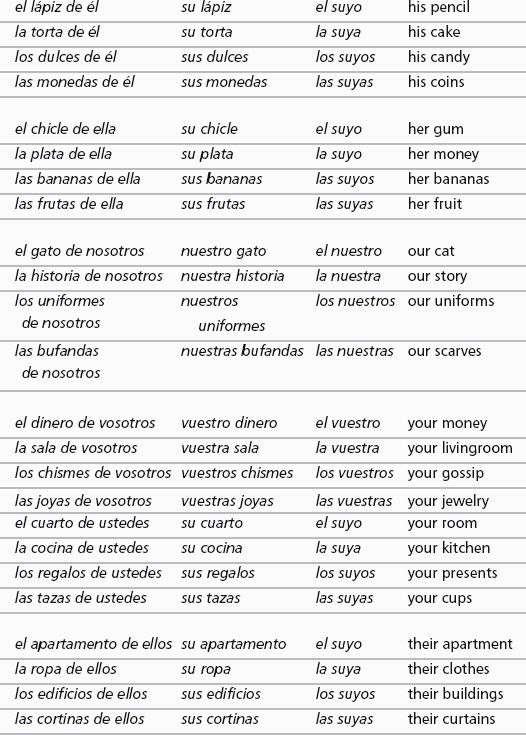The Everything Spanish Grammar Book: All The Rules You Need To Master Espanol (Everything®) (9 page)
Authors: Julie Gutin

Usted
and
ustedes
were latecomers to Spanish. The word
usted
is an abbreviated version of the phrase
vuestra merced,
“your mercy,” which was used to address royalty. Later, the phrase was shortened and its use became more widespread as a polite way of address.
Object Pronouns
Object pronouns are pronouns that receive the action of the verb (for more on how this works, see Chapter 10). In Spanish, object pronouns are divided into two groups: direct object pronouns and indirect object pronouns.
Direct object pronouns replace the direct object. For example:
Yo compré un vestido rojo. Yo lo compré.
I bought a red dress. I bought it.
The direct object answers to the question of “subject + verb + who/what?”
I bought what?
I bought a red dress.
I bought it.
“It” is therefore a direct object pronoun. In Spanish, each subject pronoun has a direct object pronoun equivalent.
Direct Object Pronouns
| singular | plural |
| me (me) | nos (us) |
| te (you, informal) | os (you, informal in Spain) |
| lo, la (you, formal) | los, las (you) |
| lo, la (him, her, it) | los, las (them) |
The verb may also have an indirect object:
Yo te compré un vestido rojo. Yo te lo compré.
I bought you a red dress. I bought it for you.
The indirect object here,
te,
answers the question, “to whom?” or “for whom?” the action of the verb is performed. Whereas in English, indirect objects may only appear if a direct object is present, in Spanish it’s possible to have an indirect object without a direct one there as well.
 ALERT
ALERT
In Spanish, when the objects are in the form of pronouns, they are placed before the verb. When both a direct and an indirect object pronoun are present, the indirect object pronouns comes first, followed by the direct object pronoun and the verb.
The following pronouns serve as indirect objects. Note that in the first and second person, the indirect object pronouns are identical to direct object pronouns.
Indirect Object Pronouns
| singular | plural |
| me (me) | nos (us) |
| te (you, informal) | os (you, informal in Spain) |
| le (you, formal) | les (you) |
| le (him, her, it) | les (them) |
When the direct and the indirect objects are both pronouns, the indirect object pronouns
le
and
les
change to
se
before
lo,
la, los,
and
las
. This is done in order to avoid confusion of saying two similar-sounding words one after another:
Yo se lo compré.
I bought it for her.
Reflexive Pronouns
Reflexive pronouns are used with reflexive verbs to show that the action of the verb is done to the subject of the verb. Take a look at the following example:
Yo me lavo en la ducha.
I wash (myself) in the shower.
Note that the subject pronoun,
yo,
refers to the same person as the reflexive pronoun,
me.
One way to think of this relationship is to remember that the reflexive pronoun reflects back to the subject of the sentence. In English, this is done with pronouns that end with –self and –selves.
Reflexive Pronouns
| singular | plural |
| me (myself) | nos (ourselves) |
| te (yourself, informal) | os (yourselves, informal) |
| se (yourself, formal) | se (yourselves) |
| se (himself, herself, itself) | se (themselves) |
In addition to working reflexively, reflexive pronouns may be used reciprocally. In English, this is done by using the phrases “each other” and one another”:
Nos queremos mucho.
We love each other a lot.
 ESSENTIAL
ESSENTIAL
Many of the verbs that are reflexive in Spanish don’t work the same way in English. For example,
me levanto
is translated as “I get up,” not “I get up myself.” For a review of reflexive verbs, see Chapter 10.
Whose Is It, Anyway?
Possessive pronouns are pronouns that represent the possessor or owner:
Es el sombrero de Jorge. Es su sombrero.
It’s Jorge’s hat. It’s his hat.
Possessive pronouns may work as adjectives modifying a noun, as in the previous example, where
su
describes
sombrero.
Possessive Pronouns as Adjectives
| singular | plural |
| mi (my) | nuestro, nuestra, nuestros, nuestras (our) |
| tu (your, informal) | vuestro, vuestra, vuestros, vuestras |
| (your, informal in Spain) | |
| su (your, formal) | su (your) |
| su (his, her, its) | su (their) |
Note that the nuestro and vuestro must agree in number
and gender with the object of possession:
| nuestro perro | our dog |
| nuestra oficina | our office |
| nuestros perros | our dogs |
| nuestras oficinas | our offices |
On the other hand,
su perro
can mean “your dog” (formal singular or plural), “his dog,” “her dog,” or “their dog.”
Possessive Pronouns as Nouns
In a modified form, possessive pronouns can replace nouns or noun phrases. Take a look at the following example:
Es el sombrero de Jorge. Es su sombrero. Es suyo.
It’s Jorge’s hat. It’s his hat. It’s his.
In English, the same word, “his,” is used as a possessive adjective and possessive noun (this is not true of all forms, like “my/mine”). In Spanish, the following pronouns are used to replace a possessive noun phrase:
Possessive Pronouns as Nouns

To choose the right possessive pronoun, you’ll need to consider the possessor as well as the object possessed. The right pronoun will take the form of the possessor, but agree in number and gender with the object possessed:


This, That, and the Other
Demonstratives are generally used to refer to something by pointing to it, either literally or physically:
Esta casa es mía.
This house is mine.
Ésta es tuya.
This is yours.
In the first example, the demonstrative
esta
is used as an adjective, describing
casa.
In the second example,
ésta
is used as a pronoun, which has replaced the noun phrase
esta casa.
In Spanish, demonstratives used as pronouns carry an accent mark to distinguish them from demonstrative adjectives.
In English, there are two sets of demonstratives: “this” and “these” are used to refer to things near the speaker; “that” and “those” are used for objects far from the speaker. In Spanish, there are three levels of demonstratives:
1. When the object is near the speaker, use
este, esta, estos,
estas, éste, ésta, éstos,
or
éstas
.
2. When the object is near the person spoken to, use
ese, esa,
esos, esas, ése, ésa, ésos,
or
ésas
.
3. When the object is not near the speaker or near the person spoken to, use
aquel, aquella, aquellos, aquellas, aquél, aquélla,
aquéllos,
or
aquéllas.
In all three forms, demonstratives must agree in number and gender with the object they describe or refer to:
Este restaurante es bueno. Éste es bueno.
This restaurant is good. This one is good.
Esa canción es bonita. Ésa es bonita.
That song is pretty. That one is pretty.